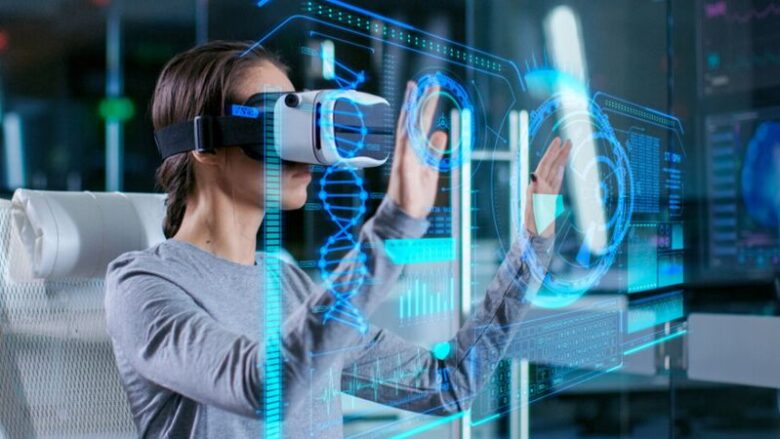Virtual reality (VR) and augmented reality (AR) are active technologies that change our experience, not imaginary concepts. As technology advances, the boundaries between the physical and digital worlds are rapidly blurring. AR uses digital overlays to enhance the real world; VR transports users to a completely virtual world. The combination of these technologies creates entirely new ways to connect with content, people, and the environment around you. Whether you’re overlaying data on your real world or exploring a virtual landscape, the perception of real things will change. AR and VR will merge in the coming years to create a seamless experience that challenges us to explore the boundaries between the real and digital worlds.
AR Glasses Becoming Everyday Wearables
Lightweight and stylish AR glasses, designed for everyday use, are one of the most anticipated AR innovations. These glasses will eventually replace or enhance the functionality of mobile phones by displaying relevant data directly in your field of vision. AR glasses are becoming personal assistants on your face, doing everything from reading foreign texts in real time and consulting work-related data to verifying instructions and messages. Companies such as Apple, Meta, and Google have invested heavily in this area. As AR glasses become more affordable and comfortable, they will become more popular with a wide range of users and integrate naturally into both personal and professional environments. This will change the way we communicate, learn, and access information in our daily lives.
VR Takes the Lead in Training and Education
Virtual reality is revolutionizing education by making learning dynamic, immersive, and fun. Students can now experience historical events or scientific phenomena in a virtual world, rather than just learning about them. This experiential learning approach improves retention and comprehension. In professional training, VR simulates real-life events without the risk of exposure. For example, pilots, doctors, and emergency responders can repeatedly navigate complex situations in a controlled environment. VR will play a particularly important role in the democratization of education in 2025 and beyond, as it will give students around the world access to high-quality knowledge and training without having to be physically present or buy expensive equipment.
AR and VR in Healthcare are Transforming Patient Treatment
Healthcare is using AR and VR to improve diagnosis, treatment, and medical training. To improve accuracy, AR allows surgeons to overlay digital images onto patients during surgical procedures. VR can help patients with their physical rehabilitation by providing interactive activities in an immersive environment. Through controlled simulations, VR can also help treat mental health conditions such as phobias, anxiety disorders, and post-traumatic stress disorder. As these technologies develop, telemedicine will become increasingly popular, as it allows physicians to examine and treat patients remotely. Specialists will have powerful tools to improve treatment outcomes, while the patient experience becomes more personalized and less intrusive.
Social Interactions in the Metaverse Regulate Connections
The concept of the metaverse is expected to transform the way we socialize and connect with each other. People can interact with each other as digital avatars, attend virtual concerts, visit 3D scenes, and work virtually in a shared virtual space in a virtual office. These activities will become increasingly realistic as realistic digital avatars, speech recognition, and spatial sound technologies develop. The metaverse creates a sense of presence that is lacking in traditional online environments. As virtual social platforms become more advanced, people will build closer relationships, have meaningful conversations, and create memories in digital environments. This trend will redefine our understanding of proximity, relationships, and shared experiences.
Retail and E-Commerce Reimagined by Immersive Tech
AR and VR are changing consumer behavior by creating highly interactive shopping environments. With AR, customers can try on clothes, view furniture in their home, and even check out a new car in their driveway without leaving their home. VR takes things a step further by creating virtual stores where consumers can browse the shelves, view items, and even purchase them in real time. These technologies increase customer satisfaction and help reduce the uncertainty of online shopping. In the future, shopping will combine physical and virtual experiences, giving customers more motivation, confidence, and convenience in their decision-making.
Gaming and Entertainment Usher in a New Era
The most developed areas for AR and VR applications are entertainment and gaming. Virtual reality headsets already offer immersive gaming where users can interact, physically move, and experience a sense of presence. Augmented reality takes mobile gaming to the next level by adding realistic scenes to games. This trend is quickly shifting to a more sensory experience with haptic feedback, realistic graphics, and advanced motion tracking. Immersive environments are also helping people relive movies, concerts, and live events. These activities will not only entertain consumers in the coming years but also engage them emotionally and physically, transforming passive spectators into active participants.
Virtual Spaces Enhance Work and Collaboration
The workplace is evolving, and AR and VR are playing a major role in this transformation. Digital whiteboards, 3D desks, and virtual meeting rooms enable teams to work virtually with the same efficiency as in person. Employees can interact with tools and data directly, even when they are in different places around the world. VR also enables immersive training and onboarding processes, reducing costs and increasing efficiency. AR can support practical work by displaying instructions directly in the employee’s field of vision. As hybrid and remote work models become the norm, these tools will drive productivity, innovation, and engagement like never before.
Conclusion
AR and VR are positive forces that are changing the way we live, work, educate, and interact with others; they are more than just experimental technologies. Devices such as AR glasses, VR headsets, and smart environments will gradually integrate them into our daily lives in the coming years. From transforming healthcare and education to transforming retail, entertainment, and social interaction, the possibilities of these immersive technologies are endless. As AR and VR evolve, they will blur the lines between the digital and the real world, delivering experiences that are both magical and useful. The future is immersive, and these trends will shape how we see and interact with our surroundings.
FAQs
1. Which is better, AR glasses or VR headsets?
They serve different purposes. AR glasses augment the real world with digital overlays; VR headsets envelop you in a virtual environment. Depending on the activity, each technology has specific applications.
2. Is VR just for gaming?
In fact, VR has applications in many areas beyond gaming, including social interaction, education, healthcare, workforce development, virtual tourism, and more.
3. Can VR and AR help improve mental health?
Anxiety, phobias, and post-traumatic stress disorder (PTSD) are already being treated with VR therapy. The calming, therapeutic environment that AR and VR create can help improve mental health.
4. Will VR and AR replace the traditional office?
While they won’t replace offices entirely, they will significantly improve remote collaboration, training, and team engagement in virtual workspaces.
5. Is it safe to use AR and VR for long periods of time?
Most devices are safe when used correctly; however, prolonged use can cause eye strain or irritation. It is advisable to maintain a positive experience by taking regular breaks and using them in moderation.




